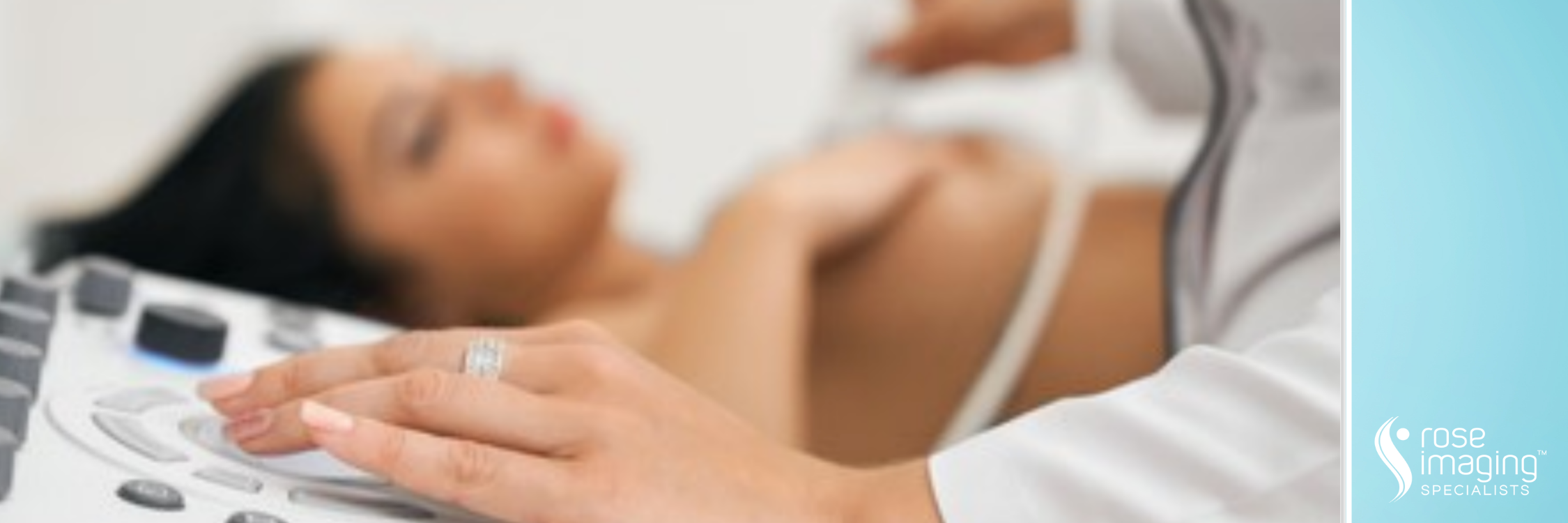Ultrasound guidance is used to remove tissue samples in these three biopsy procedures:

A breast biopsy is the process of removing a small tissue sample from the breast for further evaluation in a laboratory. The doctors at Rose Imaging Specialists perform different types of breast biopsies, depending on the type and nature of the mass found within the breast.
In an ultrasound-guided breast biopsy, ultrasound imaging is used by the radiologist to guide the biopsy devise to the site of the abnormality.
When is an Ultrasound-Guided Biopsy needed?
An ultrasound-guided breast biopsy can be performed when a breast ultrasound shows an abnormality such as:
Ultrasound guidance is used to remove tissue samples in these three biopsy procedures:
CNB which uses a large hollow needle to remove one sample of breast tissue per insertion. These biopsies are minimally invasive needle biopsies using ultrasound to show the abnormality to provide guidance for tissue sampling. The first part of the procedure will seem much like your original breast ultrasound. You will be positioned lying face up on the examination table or turned slightly to the side. Prior to your procedure, the skin is cleaned and prepped. Then, numbing medication is injected into the skin and breast tissue. Pressing the transducer to the breast, the radiologist will locate the lesion. A very small nick is made in the skin, just large enough to allow access for the core biopsy needle. The radiologist, constantly monitoring the lesion site with the ultrasound probe, will insert the needle and advance it directly into the mass to obtain the tissue samples. Once the samples are obtained, a clip is placed at the biopsy site to mark where the tissue was sampled. This will be seen on future mammograms. If surgery is needed based on biopsy results, the marker serves as a guide, allowing the radiologist to direct the surgeon to the area that needs to be removed. Once the tissue samples are obtained, they are submitted to a pathologist for analysis. Results are usually obtained within five working days. Ultrasound-guided Cyst Aspiration is a procedure allowing a radiologist to remove fluid from a symptomatic or painful cyst. Using ultrasound imaging, the radiologist can determine the exact location of the cyst. Precisely positioning a needle within the breast, the radiologist then drains the fluid from the cyst. A thinner needle is used for aspiration compared to core biopsy, and clip placement is not needed in most cases. A technologist and radiologist will be working together during your procedure. You will lie on your back or be turned slightly to the side on a padded table. Ultrasound will be used to identify the location of the cyst(s). The radiologist will insert a thin needle into your breast to drain the cyst(s). The fluid from the cyst will drain into a syringe and the cyst will collapse. Fluid obtained from a cyst aspiration is usually discarded and only in special circumstances sent for laboratory testing. A bandage will be applied over the puncture site. Cyst Aspirations typically take between 15 and 30 minutes to complete. FNA is most commonly used to extract sample cells from an enlarged lymph node. The needle used is thinner than in core needle biopsy. A technologist and radiologist will be working together during your procedure. You will lie on your back or be turned slightly to the side on a padded table. The skin will be cleaned and a small amount of local anesthetic will be applied to numb the area. Ultrasound is used to locate the enlarged lymph node, and cells are obtained through a needle. Samples are then provided to the pathologist for diagnosis. Fine Needle Aspirations typically take between 15 and 30 minutes to complete. There are no diet restrictions prior to this procedure, but you may prefer a light meal so that you will be more comfortable. Prior to a needle biopsy, you should report to your doctor all medications that you are taking, including herbal supplements, and if you have any allergies, especially to anesthesia. In order to reduce the risk of bleeding during the procedure, we recommend that patients not take any aspirin or ibuprofen product (such as Advil or Motrin) for five days prior to the procedure. If you are on prescription blood thinning medication such as Coumadin, our staff can assist you in consulting your physician prior to scheduling this exam to see if you should continue this medication.
Core Needle Biopsy (CNB)
During Your Core Needle Biopsy
Ultrasound-Guided Cyst Aspiration
During Your Ultrasound-Guided Cyst Aspiration
Fine Needle Aspiration (FNA)
During Your Fine Needle Aspiration
Before Any Type of Ultrasound-Guided Biopsy
